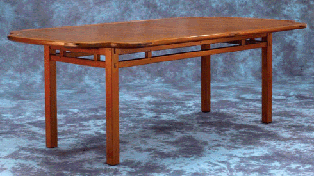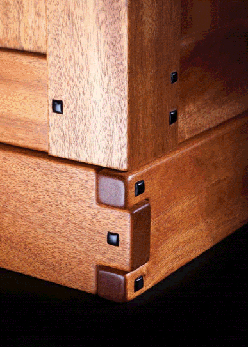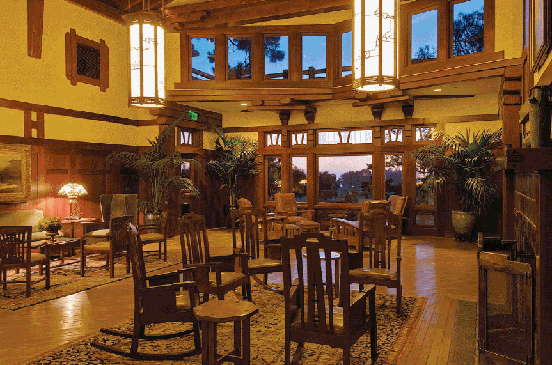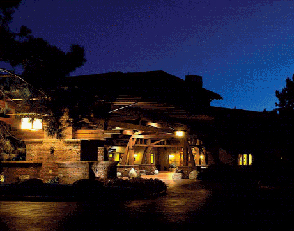
A Century Later

“A man may die, nations may rise and fall, but an idea lives on.”
JOHN F. KENNEDY
In the early years of the 20th century, Charles and Henry Greene designed, and Peter and John Hall and their workmen built an impressive body of work, including some of the most highly regarded pieces to arise from the Arts & Crafts movement. A century later, an ever broader audience appreciates the Greene & Greene legacy thanks to the efforts of many individuals. These include the enlightened owners of Greene & Greene houses, museum curators, the staff of The Gamble House and a number of craftsmen who continue the craft of the Greenes and Halls by creating new works in their style. This latter group includes many talented woodworkers, glass artists and architects — far too many to discuss here. Instead we highlight three individuals responsible for inspired, and inspiring, reproductions and new creations, and one destination that introduces visitors to the Greene & Greene style in a magical setting.

Clearly inspired by Greene & Greene, this hanging lantern pays homage but is also original. Note the variation in width of the lead work. Woodwork by Thomas Stangeland. Dining room lantern, 2006, John Hamm.
John Hamm
Each fall, on the third weekend in October, Pasadena plays host to a highly anticipated event — Craftsman Weekend. A venture of Pasadena Heritage, Craftsman Weekend gives visitors the opportunity to tour historic homes, including bungalows in Pasadena’s Bungalow Heaven neighborhood and, quite often, a house by Greene & Greene. Houses on the schedule in recent years have included the Cordelia Culbertson house, the Edgar Camp house, the Caroline de Forest house, the Laurabelle Robinson house and the Freeman Ford house. In addition, each year the weekend includes a marketplace where antique dealers and craftspeople exhibit and sell their wares. Included in the marketplace is a silent auction.

While this window frame is obviously Greene & Greene, the glass is not. The birds are hand-cut from lead sheet. Window, 2008, John Hamm.
During Craftsman Weekend 2007, I bid on a beautiful, small art glass panel made by one of the exhibitors. Looking as though it was straight out of a Greene & Greene house, this piece already had a place in my home, if only in my mind. That’s as close as it came to my home — I was outbid. I learned later that the successful bidder was 12 years old, I had lost to a child. Apparently, a well-funded child. More than two years later, I can still see that beautiful stained glass, by Southern California artist John Hamm, so similar in style to the wonderful work of Emil Lange.
John Hamm knows the work of Greene & Greene. He is a long-time docent at the Gamble house and has done conservation work there. His work — reproduction, conservation or original — also appears in the Freeman Ford house, the William Thorsen house, the Laurabelle Robinson house and the Robert Blacker house. The glass in the Blacker front doors and transom, three layers thick, is by John, done in the late 1980s after the original doors were removed from the house and sold.
John does not work exclusively in the style of Greene & Greene. His portfolio is varied and includes traditional work, modern designs and at least one Tiffany lamp reproduction. The methods used are varied as well to suit the project. For the organic feel required for some Greene & Greene pieces, he uses copper foil construction to facilitate the broad variation in the width of the leading, while many other jobs call for more conventional lead came assembly. Regardless of the technique, the results are beautiful and worthy of a place alongside the original work so stunningly executed by Emil Lange a century ago.
Darrell Peart
Seattle-based woodworker Darrell Peart designs and builds high-quality furniture in the spirit of Greene & Greene. While Darrell does make some reproductions, he is best known for his original pieces. In particular, his line of Aurora case pieces are a wonderful modern interpretation of the Greene & Greene aesthetic. Modern in this context means well-suited to a 21st century home, with pieces such as a media cabinet (100 years ago, a media cabinet had another name: magazine stand). As one would expect of studio furniture, fit and finish are perfect. This may help explain a backlog of work that often approaches a year.

Combining the Greene & Greene vocabulary with his own touches (drawer pulls, curved, lifted rails) makes this piece both familiar and new. Media cabinet, 2007, Darrell Peart.

A tsuba-inspired top with a more traditional rectangular base makes for a light, modern interpretation in this piece. Tsuba table, 2009, Darrell Peart.
In addition to making furniture, Darrell writes frequently about topics related to the work of Greene & Greene. His book, Greene & Greene: Design Elements for the Workshop is a must have for any woodworker with an interest in the Greenes. Each year Darrell teaches a handful of woodworking classes at the William Ng School of Fine Woodworking in Southern California and the Port Townsend School of Woodworking in Washington.
Jim Ipekjian
Jim Ipekjian has the distinct pleasure of working in Pasadena, California, home to most of the houses designed by Greene & Greene. His shop is a short drive from the Gamble house (one might be tempted to say “short walk” except in Southern California). At any given time, it is quite likely that the shop contains a Greene & Greene reproduction in some state of semi-completion. Jim’s reputation has been built, and maintained, on such pieces — exquisite reproductions of Greene & Greene designs. His relationships with clients are often ongoing and long lasting. He has been involved with the restoration of the Blacker house for roughly 15 years.


Many hobbyist woodworkers create furniture in the Greene & Greene style. This piece includes pegs, lifts, finger joints, breadboard ends and “sunburst stiles” that draw from elements in windows at the Gamble house. Chest, 2007, David Mathias.
Jim’s pieces are all but indistinguishable from originals. In fact, he marks each piece to ensure that there is never a question as to its origin. Impressively, Jim creates each piece from start to finish, including inlays and glass. It is likely that no living person knows more about Greene & Greene furniture. Because of that knowledge, Jim leads the monthly Details & Joinery tours at the Gamble house, giving participants a rare opportunity to examine original pieces and ask questions of one of the few people who might know the answer.
Lodge at Torrey Pines
As mentioned in the Preface, the Lodge at Torrey Pines is located on a magnificent site overlooking the Pacific Ocean in La Jolla, California. The current incarnation of the lodge, one befitting the setting, is a recent invention. Once more like a roadside motel than a high end hotel, the Lodge at Torrey Pines is now a monument to the best work of Charles and Henry Greene. The public spaces of the lodge contain elements from the Gamble, Blacker, Thorsen and Pratt houses, somehow incorporated into a structure that must meet the rigorous building codes of a modern hotel.

Accurately recreating an inlay such as this may be more difficult than making it the first time. Detail, Blacker living room desk, c. 2006, Jim Ipekjian.

Is it real or is it Ipekjian? Faithful re-implementations of original Greene & Greene designs. Detail, Blacker living room armchair, c. 2007, Jim Ipekjian.
On approaching the lodge, one rounds a bend and encounters a porte cochere inspired by that at the Blacker house, signaling even the uninitiated that this is a unique inn. Walking through the art glass entrance, one enters the lobby, which is the most satisfying of the lodge’s Greene & Greene vignettes. It is a very inviting spot with architectural details and furniture working in concert to achieve a warmth seldom found in a hotel. The dining room of the signature restaurant is also quite compelling, complete with Blacker basket lanterns in the center of the room and Gamble hanging lanterns at booths around the perimeter. Enhancing the experience are truly outstanding food and service. The energy that owner Bill Evans brought to creating the lodge has continued in the way that it is run. As with Greene & Greene, attention to detail — in this case, for customer care — is paramount.

With the Pacific Ocean and sunset through the window and a multitude of Greene & Greene-inspired furniture and decorative arts, this is a very inviting spot. Lobby, The Lodge at Torrey Pines, La Jolla, 2002.

It is unlikely that any other hotel in the world has an entrance similar to this one. As was true 100 years ago, there are cheaper ways to build but arguably none more beautiful. Detail of east façade, The Lodge at Torrey Pines.
That statement applies as well to the work of John Hamm, Darrell Peart and Jim Ipekjian. Whether consciously or subconsciously, each pays tribute to Greene & Greene not only with the work that they produce but also with the way in which they work. Paying attention to the details, and getting them right, was one of the keys to the success enjoyed by Charles and Henry Greene. So it is in the present day. Some, it would seem, still recognize the extraordinary and are willing to engage talented craftsmen in order to obtain it.